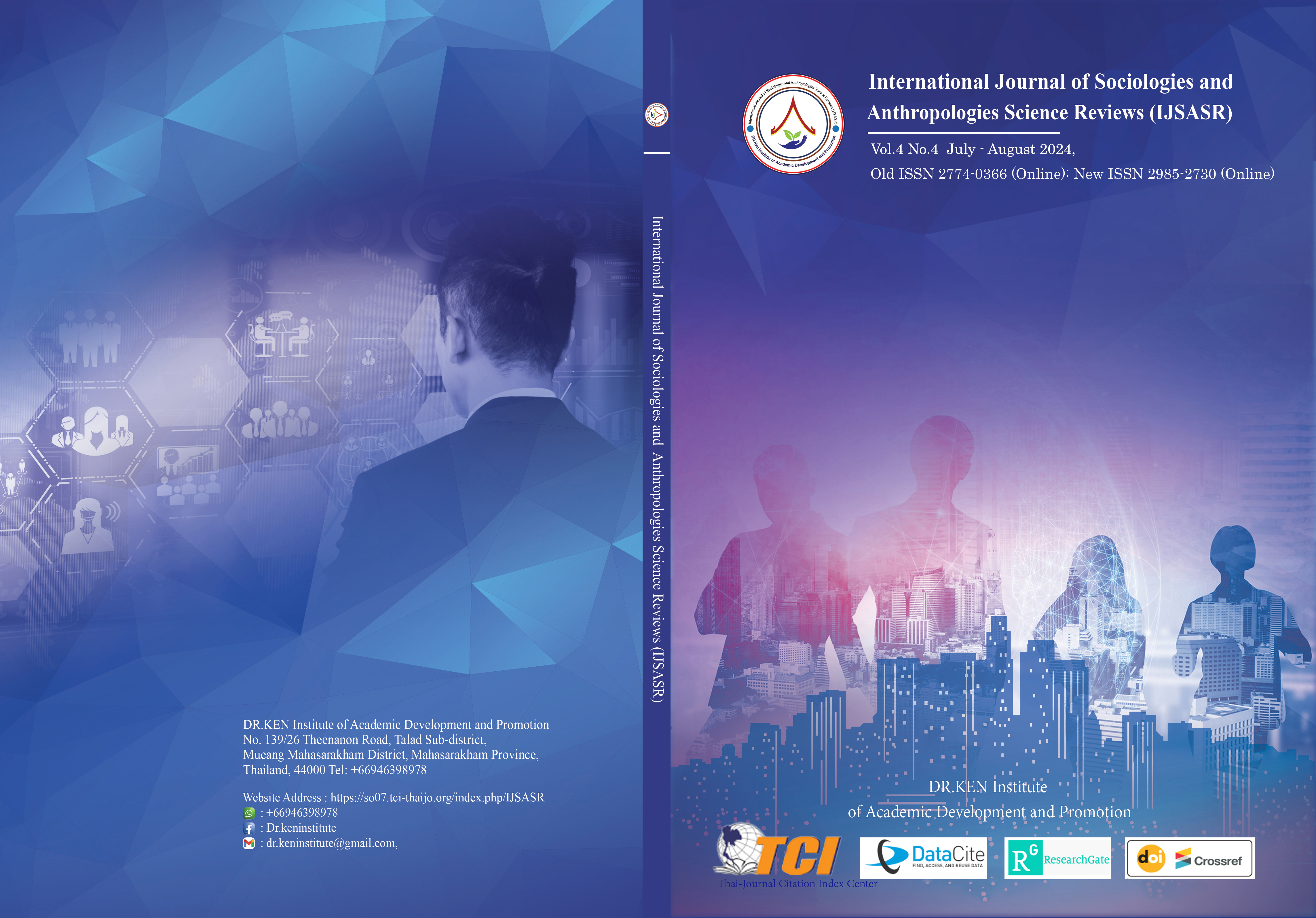The Current Status and Musical Characteristics of Xiatan Chuanfuqu Songs in an Anthropological Context
Main Article Content
Abstract
Background and Aims: Xiatan Chuanfuqu songs represent a significant cultural heritage rooted in boatmen's laborious yet harmonious lives navigating the rivers of China's Sichuan and Chongqing regions. This anthropological study aims to explore the current status and musical characteristics of Xiatan Chuanfuqu songs in an anthropological context.
Materials and Methods: Comprises a comprehensive literature review, incorporating anthropological theories on music, cultural heritage preservation, and sociological analyses of folk music transmission. Qualitative methods, including semi-structured interviews, ethnographic observations, and content analysis, were employed to gather rich data on the evolution of these songs, their cultural significance, and the challenges they face in contemporary society.
Results: Reveal the intricate musical elements, such as rhythmic patterns, vocal techniques, lyrical content, and melodic nuances, reflecting the boatmen's experiences, camaraderie, and challenges encountered on the rivers. Even though modernization has made younger people less interested and traditional singers are getting older, the study shows how important it is to use comprehensive preservation strategies and encourage community involvement to ensure that Xiatan Chuanfuqu songs are passed on and remain important as intangible cultural heritage.
Conclusion: Emphasizes the need for collaborative efforts among cultural institutions, local communities, and educational initiatives to safeguard and promote these unique musical traditions for future generations.
Article Details

This work is licensed under a Creative Commons Attribution-NonCommercial-NoDerivatives 4.0 International License.
Copyright on any article in the International Journal of Sociologies and Anthropologies Science Reviews is retained by the author(s) under the under the Creative Commons Attribution-NonCommercial-NoDerivatives 4.0 International License. Permission to use text, content, images, etc. of publication. Any user to read, download, copy, distribute, print, search, or link to the full texts of articles, crawl them for indexing, pass them as data to software, or use them for any other lawful purpose. But do not use it for commercial use or with the intent to benefit any business.

References
Antons, C., & Logan, W. (2017). Intellectual and cultural property and the safeguarding of intangible cultural heritage. In Intellectual Property, Cultural Property and Intangible Cultural Heritage (pp. 1-17). Routledge. https://doi.org/10.4324/9781315714288-1
Chabrowski, I.I. (2015). Singing on the river: Sichuan boatmen and their work songs, 1880s-1930s. In Singing on the River. Brill. https://doi.org/10.1163/9789004305649
Chen, C. (2022). The Development of Mudong Folk Song in Ba nan District, Chongqing, China. Doctoral dissertation: Mahasarakham University.
Gang, Y. (2022). Historical Geography of Hejiang Town in Poetry and Ballads. International Journal of Frontiers in Sociology, 4(1), 83-88. https://doi.org/10.25236/IJFS.2022.040116
Ghosh, D., & Muecke, S. (2009). 'The Fisherman's Lot': Popular responses to the Indian Ocean in economic and ecological crisis. In Water, Sovereignty and Borders in Asia and Oceania (pp. 86-100). Routledge. https://doi.org/10.4324/9780203884676
Hobsbawm, E., & Ranger, T. (1983). The invention of tradition. Cambridge University Press.
Hodges, J., & Baron, C. (2011). Cultural sustainability: Aligning aesthetics and social practice in cultural heritage conservation. In K. Jones (Ed.), Heritage, conservation, and communities: Engagement, participation, and capacity building (pp. 67-78). Boydell Press.
Labadi, S. (2013). UNESCO, cultural heritage, and outstanding universal value: Value-based analyses of the World Heritage and Intangible Cultural Heritage conventions. AltaMira Press.
Li, Z. (2021). Influences of Chinese Cultural Traditions on Piano Music by Chinese Composers: Analytical Study of Representative Piano Works Through 1980, With Pedagogical and Performance Considerations. Doctoral dissertation: University of Northern Colorado.
Lin, Q.F. (2018). Music in The River's Song by Suchen Christine Lim. Journal of Ecocriticism, 8(1), 11-19.
Liu, A. (2022). "Regenerating" Tradition: A Cultural Memory Method to Reshape the Living Inheritance of Intangible Cultural Heritage of Ethnic Minorities. In 2022 3rd International Conference on Language, Art and Cultural Exchange (ICLACE 2022) (pp. 647-656). Atlantis Press. https://doi.org/10.2991/assehr.k.220706.123
Liu, W., & Si, S. (2022). Disruptive innovation in the context of retailing: digital trends and the internationalization of the Yiwu Commodity Market. Sustainability, 14(13), 7559. https://doi.org/10.3390/su14137559
Luo, X., & Suanmonta, T. (2024). Anthropological Perspectives on the Historical Development of Salar Folk Songs in Qinghai Province, China. International Journal of Sociologies and Anthropologies Science Reviews, 4(2), 289-298. https://doi.org/10.60027/ijsasr.2024.3965
McCormick, C.T., & White, K.K. (Eds.). (2010). Folklore: An Encyclopedia of Beliefs, Customs, Tales, Music, and Art,[3 volumes]:[3 volumes]. Bloomsbury Publishing USA.
Merriam, A.P. (1964). The anthropology of music. Northwestern University Press.
Nettl, B. (2005). The study of ethnomusicology: Thirty-one issues and concepts. University of Illinois Press.
Richardson, J. (2012). River Soundscapes: Ecological Perspectives in the Music of Annea Lockwood, Eve Beglarian, and Leah Barclay. Arizona State University.
Smith, L. (2006). Uses of heritage. Routledge. https://doi.org/10.4324/9780203602263
Titon, J.T. (2008). Worlds of music: An introduction to the music of the world's peoples. Cengage Learning.
UNESCO. (2003). Convention for the safeguarding of the intangible cultural heritage. United Nations Educational, Scientific and Cultural Organization.
Waldburger, L. C. (2018). Traditional Group Work Songs: Implications for Modern Music Therapy Practices. Drexel University.
Weisgrau, M., Rosman, A., & Rubel, P. G. (2023). The tapestry of culture: An introduction to cultural anthropology. Rowman & Littlefield.
Wu, K. (2023). Cultural Confluence: The Impact of Traditional and Modern Synergies in Chinese Juvenile Musical Theater. International Journal of Education and Humanities, 11(2), 192-199. https://doi.org/10.54097/ijeh.v11i2.13825
Yang, J., & Theerapan, S. (2024). The Contemporary Status of Pingxian Folk Songs and Their Educational Significance in Qinghai Province Through Anthropological Analysis. International Journal of Sociologies and Anthropologies Science Reviews, 4(2), 367-378. https://doi.org/10.60027/ijsasr.2024.4013
Yang, L., & Chonpairot, J. (2024). Preservation and Promotion of Literacy through Performing Arts Education of Chuanjiang Haozi in Chongqing Province, China. International Journal of Education and Literacy Studies, 12(1), 155-161. https://doi.org/10.7575/aiac.ijels.v.12n.1p.155
Zou, S. (2019). When nationalism meets hip-hop: Aestheticized politics of Ideotainment in China. Communication and critical/cultural studies, 16(3), 178-195. https://doi.org/10.1080/14791420.2019.1637008






